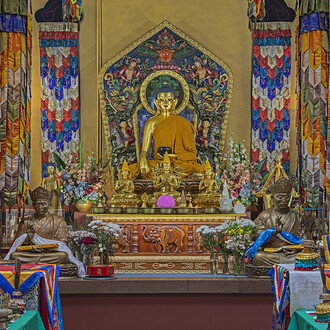“The latest distinctive exhibition makes public a splendid collection and a fascinating account of brilliant processes in the development of Russian culture. Artistic glass was, and still is, an important ‘marker’ for the development of art, closely bound up with technological achievements. The masterpieces come together in an interesting narrative about the creative insights of craftspeople in various places in Russia that produced its artistic image,” Mikhail Piotrovsky, General Director of the State Hermitage, says.
The display contains more than 100 works from the collection of the State Hermitage that demonstrate the main stages in the development of the production of cut glass in Russia and the range of methods used in the mechanical working of glass surfaces.
Over the course of their history, pieces of glassware decorated by cutting or engraving underwent changes following the fashion trends of the period. At times they became exceptionally popular, at others practically vanished from use. In Russia a high-powered centre for the manufacture of glass and crystal wares formed in Saint Petersburg, at the Imperial Glassworks. There outstanding artists, architects, craftsmen and technicians produced some exclusive pieces to original designs. The vigorous development of artistic glassware with incised decoration was undoubtedly stimulated by the main clientele of the Imperial Glassworks – members of the court. It was their tastes that the artists and craftsmen sought to satisfy in creating some one-of-a-kind pieces.
The exhibition in the Small Church of the Winter Palace invites visitors to immerse themselves in the rich history of glassmaking, to discover the secrets of this artistic craft and to assess the contribution that Russian craftspeople made to the development of a worldwide artistic tradition.
One of the earliest exhibits is a unique work of art – a glass Easter egg engraved with depictions of Our Lady of Azov that was made at the Yamburg Glassworks in the first quarter of the 18th century. The engraved image on the piece is gilded, while the inner surface was silvered.
In 18th-century Russia, the practice of decorating glass by cutting and engraving blossomed. The Saint Petersburg Glassworks became the centre for the production of grand tableware richly finished with incised ornamentation. There, clear transparent glass was used to make goblets and drinking vessels of various sizes that were engraved with heraldic symbols, laudatory inscriptions and depictions of ruling monarchs. Articles of this kind, including a goblet bearing a portrait of Empress Elizabeth, a double-headed eagle and the monogram EIP, appear in the display.
In the early 19th century, a fashion developed for items made of faceted crystal – clear lead glass that bore an outward resemblance to the natural rock of the same name. Crystal fitted harmoniously into the daily life of the court and the aristocracy. Services with many pieces became an inseparable part of the adornment of a festive table, while monumental vases further enhanced the decor of state rooms. Crystal glass of the highest quality was manufactured at the Imperial Glassworks – the Russian Empire’s foremost enterprise in this sphere. When visiting an exhibition of the glassworks’ finest offerings to the court in 1823, the well-known publicist Pavel Svinyin was impressed above all by “the sparkle of crystal and fineness of facets” on the articles presented to his gaze. It was the Imperial Glassworks in the 1820s that produced a clear crystal casket that belonged to Emperor Nicholas I and Empress Alexandra Feodorovna. Seeking to please the Empress, the works’ craftsmen produced an object that had the glittering appearance of a cut diamond.
At the turn of the 20th century, the range of glassware expanded considerably thanks to innovations in technology. The exhibits that tell about the new methods of working glass being used by Russian craftspeople include a vase with a depiction of a snake among clumps of clover (1898); a Poppy and Butterflies vase (1897), the Azalia vase (1901) and a vase with a depiction of a landscape with cypress trees (early 20th century).
This exhibition has been prepared by the State Hermitage’s Department of the History of Russian Culture (headed by Viacheslav Feodorov). The curator and author of the concept for the exhibition is Tatiana Nikolayevna Pankova, senior researcher in that department and keeper of the collection of Russian glass.
The State Hermitage Publishing House has produced a special publication in Russian to accompany the exhibition Blesk kristalla i tonkost’ granei… Russkoe steklo XVIII – nachala KhKh veka s rez’boi i gravirovkoi [The sparkle of crystal and fineness of facets…. Carved and engraved russian glass of the eighteenth – Early twentieth centuries]. The compiler and author of the text is Tatiana Pankova.
The exhibition can be visited by all holders of entrance tickets to the Main Museum Complex.
















